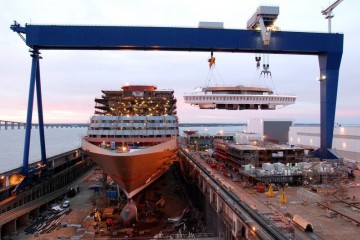What could disruptive innovation in container shipping look like? Surely a timely question. We have only started, but 2017 is already full of all kinds of disruptions; why would container shipping remain unaffected? There are obviously different approaches to this question; mine is the interplay of business strategy and government policy.
The dominant business strategy in container shipping is economies of scale. Or: big is beautiful. The average capacity of a containership has quadrupled in two decades. Over more or less the same period, container shipping has developed from a fragmented industry into an oligopoly. We have seen over the past few years a wave of mergers in container shipping. The result: in 2018, when these mergers have all materialised, the top 7 container lines will have a 77% market share. Other indicator: we have – since 1st April 2017 – three container shipping alliances that cover 95% of the East-West traffic. To put it slightly more technically: we have witnessed a process of horizontal integration in container shipping.
This process has been enabled by government policy. Governments have approved mergers and been uncritical of alliances, with the notable exception of China on the proposed P3-alliance in 2014. Governments has also provided state aid – in the form of favourable tax regimes, such as tonnage taxes – that have made it possible for shipping companies to order bigger ships, and to survive the shipping crisis, which they created themselves by ordering too many ships, made possible by state aid.
We have reached the limits of economies of scale. Ships can technically grow bigger than their current maximum size, but the cost savings from getting bigger become negligible, so this is becoming a strategic cul-de-sac. The concentration in the industry also limits the obvious synergies from mergers: the number of smaller players to be eaten up is becoming limited. Moreover, the development of alliances has reached its regulatory limit. E.g. the EU consortia regulation stipulates a 30% threshold for alliances, which has now been reached with three large alliances covering 95% of the East-West container traffic.
With the strategy of horizontal integration coming to its logical end, container shipping will need to find another trick. And this is where a business strategy will come at hand that has for the moment has played second fiddle: vertical integration. So, shipping taking over other parts of the maritime supply chain. In itself, this is nothing new. Many shipping lines have invested in container terminals. A prominent example is APM Terminals, the terminal subsidiary of the Maersk Group, but many other shipping companies have stakes in terminals. This is arguably going to become more important, in particular for the Chinese groups that have been very active in acquiring new terminals. In addition, some shipping companies are engaged in organising land transport services: road, rail, river transport and coastal shipping. Recently, various shipping companies have also explicitly stated their ambition to be active in logistics and freight forwarding. For example, Maersk recently announced a strategy to become the “global integrator” in container shipping. CMA CGM is also clearly interested in transforming from a shipping company into a firm that provides logistics solutions. Vertical integration will become the new normal for container shipping companies.
This will be a source of disruption. For a start, it might disrupt other sectors. Freight forwarders might wonder if there is still a future for their services. The same is true for other intermediaries in the maritime supply chain. When a changing shipping business model meets the potential of digitalisation, the possibilities of disruption are endless. Hence, the emergence of new partnerships, e.g. between Alibaba and Maersk. The power of data is also a disruptive force that might strike the shipping sector itself. Think of Uber: it has been successful thanks to its mastery of information flows. Its lack of physical assets has been an advantage rather than a constraint. In the same vein, could the heavy dependence of shipping companies on their assets – ships – make them less flexible in the battle for 21st century shipping? In other words, would it be crazy to imagine high-tech start-ups with a stash of venture capital to crack the secret to a much more efficient maritime supply chain, leaving traditional shipping companies speechless? Yes, crazy it would be – as any disruptive innovation – but not impossible.
The forthcoming disruption raises new policy challenges. Is intense vertical integration of transport chains desirable? Do we want supply chains to be locked-in by a select number of multi-national companies? Can we avoid that public funds are used to enable private maritime supply chains? For example, should the EU subsidise transport corridors that are needed to connect a port of entry selected by a foreign shipping firm? Does it make sense to subsidise shipping companies that venture into business activities where they compete with companies that are not subsidised? Is it beneficial for the public interest to continue facilitating horizontal integration in container shipping that will inevitably also lead to consolidation on the land side? All these questions need honest answers. So, shipping regulators might soon need to work over-time.
3 Comments
Comments are closed.




“Back to the future” is the Maersk Line – APMT – Damco move with only additional value the blockchain playground they will add to it. E2E is becoming now their “core business” where previously they opted for Port-Port only. Sadly they transferred their land-based activities to APMT who had no clue what do to with it and sold it out. With CMA-CGM and their ILS, MSC with their Medlog and other carriers managing their land based activities we will see indeed a tendency of E2E product delivery. Soon booking a container will be as easy as buying a pair of socks as long as your creditcard can handle it. Pricing transparency will become the critical component and be the foundation of competitive pricing. Do we complain that Google is a monopolist in its market? Or Amazon? Bol.Com? Alibaba? And what will regulators do about it? Regulators will respond in the usual manner – 10 years after the cow fell overboard. Or does the market want to return to conferences?
At last! We found something where we disagree… VI was tried in the 90s and dropped in favour of HI. They won’t go back. Maersk/Alibaba is another thing. I would rather see shippers integrating the supply chain and that would be smart… 🙂
I agree with Gunther in that transparency is key. The article had an interesting opinion though Olaf I enjoyed reading it.